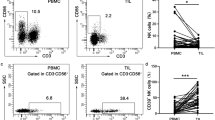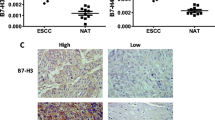Abstract
To investigate the potential role of interleukin-18 (IL-18) in immunomodulation during tumorigenesis of esophageal carcinoma and elucidate the underlying molecular mechanism, we employed IL-18 knockout mice for this purpose. Carcinogen 4-nitroquinoline 1-oxide (4NQO) was administrated in drinking water to induce occurrence of esophageal squamous cell carcinoma (ESCC). T cell activation as indicated by the surface CD molecules was analyzed with flow cytometry. The serous content of interferon-γ (IFN-γ) along with other cytokines was determined by inflammatory human cytokine cytometric bead array. The cytotoxicity assay was performed by co-culture of tumor cells with immune cells and relative cell viability was determined by lactate dehydrogenase (LDH) assay. Apoptotic cells were stained with Annexin-V/propidium iodide (PI) and analyzed by flow cytometry. Cell proliferation was measured with Cell Counting Kit-8 (CCK-8) assay. Our data demonstrated that deficiency of IL-18 promoted the progression and development of 4NQO-induced ESCC. Loss of IL-18 suppressed the activation of T cells in the esophagus. Deficiency of IL-18 inhibited the IFN-γ production by CD8+ T cells and natural killer (NK) cells. Absence of IL-18 inhibited the cytotoxicity of CD8+ T cells and NK cell in vitro. Moreover, deficiency of IL-18 promoted the apoptosis of CD8+ T cells and inhibited the proliferation of CD8+ T cells in vitro. Our data elucidated the immunomodulatory role of IL-18 during tumorigenesis of ESCC, whose deficiency compromised antitumor immunity and contributed to immune escape of esophageal carcinoma. Our results also indicated the therapeutic potential of exogenous IL-18 against ESCC, which warrants further investigations.





Similar content being viewed by others
References
Torre, L.A., F. Bray, R.L. Siegel, J. Ferlay, J. Lortet-Tieulent, and A. Jemal. 2015. Global cancer statistics, 2012. CA: a Cancer Journal for Clinicians 65: 87–108.
Lozano, R., M. Naghavi, K. Foreman, S. Lim, K. Shibuya, V. Aboyans, et al. 2012. Global and regional mortality from 235 causes of death for 20 age groups in 1990 and 2010: A systematic analysis for the Global Burden of Disease Study 2010. Lancet 380: 2095–2128.
Enzinger, P.C., and R.J. Mayer. 2003. Esophageal cancer. The New England Journal of Medicine 349: 2241–2252.
Prabhu, A., K.O. Obi, and J.H. Rubenstein. 2014. The synergistic effects of alcohol and tobacco consumption on the risk of esophageal squamous cell carcinoma: A meta-analysis. The American Journal of Gastroenterology 109: 822–827.
Zhang, H.Z., G.F. Jin, and H.B. Shen. 2012. Epidemiologic differences in esophageal cancer between Asian and Western populations. Chinese Journal of Cancer 31: 281–286.
de Jonge, P.J., M. van Blankenstein, W.M. Grady, and E.J. Kuipers. 2014. Barrett’s oesophagus: Epidemiology, cancer risk and implications for management. Gut 63: 191–202.
Stahl M., Mariette C., Haustermans K., Cervantes A., Arnold D., Group E.G.W. 2013. Oesophageal cancer: ESMO Clinical Practice Guidelines for diagnosis, treatment and follow-up. Ann Oncol 24 Suppl 6:vi51-56.
Biet, F., C. Locht, and L. Kremer. 2002. Immunoregulatory functions of interleukin 18 and its role in defense against bacterial pathogens. J Mol Med (Berl) 80: 147–162.
Akira, S. 2000. The role of IL-18 in innate immunity. Current Opinion in Immunology 12: 59–63.
Li, K., L. Wei, Y. Huang, Y. Wu, M. Su, X. Pang, et al. 2016. Leptin promotes breast cancer cell migration and invasion via IL-18 expression and secretion. International Journal of Oncology 48: 2479–2487.
Dwivedi, S., A. Goel, S. Khattri, A. Mandhani, P. Sharma, S. Misra, et al. 2015. Genetic variability at promoters of IL-18 (pro-) and IL-10 (anti-) inflammatory gene affects susceptibility and their circulating serum levels: An explorative study of prostate cancer patients in North Indian populations. Cytokine 74: 117–122.
Liu, J.M., J.N. Liu, M.T. Wei, Y.Z. He, Y. Zhou, X.B. Song, et al. 2013. Effect of IL-18 gene promoter polymorphisms on prostate cancer occurrence and prognosis in Han Chinese population. Genetics and Molecular Research 12: 820–829.
Carbotti, G., G. Barisione, A.M. Orengo, A. Brizzolara, I. Airoldi, M. Bagnoli, et al. 2013. The IL-18 antagonist IL-18-binding protein is produced in the human ovarian cancer microenvironment. Clinical Cancer Research 19: 4611–4620.
Terme, M., E. Ullrich, L. Aymeric, K. Meinhardt, J.D. Coudert, M. Desbois, et al. 2012. Cancer-induced immunosuppression: IL-18-elicited immunoablative NK cells. Cancer Research 72: 2757–2767.
Alagkiozidis, I., A. Facciabene, M. Tsiatas, C. Carpenito, F. Benencia, S. Adams, et al. 2011. Time-dependent cytotoxic drugs selectively cooperate with IL-18 for cancer chemo-immunotherapy. Journal of Translational Medicine 9: 77.
Kim, J., C. Kim, T.S. Kim, S.I. Bang, Y. Yang, H. Park, et al. 2006. IL-18 enhances thrombospondin-1 production in human gastric cancer via JNK pathway. Biochemical and Biophysical Research Communications 344: 1284–1289.
Xu, X., C. Song, Z. Chen, C. Yu, Y. Wang, Y. Tang, et al. 2017. Downregulation of HuR inhibits the progression of esophageal cancer through Interleukin-18. Cancer Res Treat.
Madankumar, A., S. Jayakumar, K. Gokuladhas, B. Rajan, S. Raghunandhakumar, S. Asokkumar, et al. 2013. Geraniol modulates tongue and hepatic phase I and phase II conjugation activities and may contribute directly to the chemopreventive activity against experimental oral carcinogenesis. European Journal of Pharmacology 705: 148–155.
Matthews, J.B., G.I. Mason, C.M. Scully, and S.S. Prime. 1986. In situ characterisation of the oral mucosal inflammatory cell response of rats induced by 4-nitroquinoline-N-oxide. Carcinogenesis 7: 783–788.
Tang, X.H., B. Knudsen, D. Bemis, S. Tickoo, and L.J. Gudas. 2004. Oral cavity and esophageal carcinogenesis modeled in carcinogen-treated mice. Clinical Cancer Research 10: 301–313.
Siegel, R., J. Ma, Z. Zou, and A. Jemal. 2014. Cancer statistics, 2014. CA: a Cancer Journal for Clinicians 64: 9–29.
Wu, I.C., C.C. Wu, C.Y. Lu, W.H. Hsu, M.C. Wu, J.Y. Lee, et al. 2013. Substance use (alcohol, areca nut and cigarette) is associated with poor prognosis of esophageal squamous cell carcinoma. PLoS One 8: e55834.
Pennathur, A., M.K. Gibson, B.A. Jobe, and J.D. Luketich. 2013. Oesophageal carcinoma. Lancet 381: 400–412.
Crusz, S.M., and F.R. Balkwill. 2015. Inflammation and cancer: Advances and new agents. Nature Reviews. Clinical Oncology 12: 584–596.
Cho, W.C., C.K. Kwan, S. Yau, P.P. So, P.C. Poon, and J.S. Au. 2011. The role of inflammation in the pathogenesis of lung cancer. Expert Opinion on Therapeutic Targets 15: 1127–1137.
Anestakis, D., S. Petanidis, S. Kalyvas, C.M. Nday, O. Tsave, E. Kioseoglou, et al. 2015. Mechanisms and applications of interleukins in cancer immunotherapy. International Journal of Molecular Sciences 16: 1691–1710.
Gao, Y.B., Z.L. Chen, J.G. Li, X.D. Hu, X.J. Shi, Z.M. Sun, et al. 2014. Genetic landscape of esophageal squamous cell carcinoma. Nature Genetics 46: 1097–1102.
Denies, S., L. Cicchelero, I. Van Audenhove, and N.N. Sanders. 2014. Combination of interleukin-12 gene therapy, metronomic cyclophosphamide and DNA cancer vaccination directs all arms of the immune system towards tumor eradication. Journal of Controlled Release 187: 175–182.
Yuan, L., H. Zhao, L. Zhang, and X. Liu. 2013. The efficacy of combination therapy using adeno-associated virus-mediated co-expression of apoptin and interleukin-24 on hepatocellular carcinoma. Tumour Biology 34: 3027–3034.
Zhao, N., X. Li, X. He, Y. Qiu, L. Zhu, and F. Qi. 2013. Interleukin-15 gene therapy and the mammalian target of rapamycin inhibitor everolimus inhibit the growth of metastatic breast cancer. The Journal of Gene Medicine 15: 366–374.
Yoshimoto, T., N. Morishima, M. Okumura, Y. Chiba, M. Xu, and J. Mizuguchi. 2009. Interleukins and cancer immunotherapy. Immunotherapy 1: 825–844.
Zhang, X., L. Zhang, W. Xu, H. Qian, S. Ye, W. Zhu, et al. 2013. Experimental therapy for lung cancer: Umbilical cord-derived mesenchymal stem cell-mediated interleukin-24 delivery. Current Cancer Drug Targets 13: 92–102.
Kaiga, T., M. Sato, H. Kaneda, Y. Iwakura, T. Takayama, and H. Tahara. 2007. Systemic administration of IL-23 induces potent antitumor immunity primarily mediated through Th1-type response in association with the endogenously expressed IL-12. Journal of Immunology 178: 7571–7580.
Yang, C., H. Cao, N. Liu, K. Xu, M. Ding, and L.J. Mao. 2016. Oncolytic adenovirus expressing interleukin-18 improves antitumor activity of dacarbazine for malignant melanoma. Drug Design, Development and Therapy 10: 3755–3761.
Author information
Authors and Affiliations
Corresponding author
Ethics declarations
Conflict of Interest
The authors declare that they have no conflict of interest.
Research Involving Human Participants and/or Animals
All applicable international, national, and/or institutional guidelines for the care and use of animals were followed.
Informed Consent
Not applicable.
Rights and permissions
About this article
Cite this article
Li, J., Qiu, G., Fang, B. et al. Deficiency of IL-18 Aggravates Esophageal Carcinoma Through Inhibiting IFN-γ Production by CD8+T Cells and NK Cells. Inflammation 41, 667–676 (2018). https://doi.org/10.1007/s10753-017-0721-3
Published:
Issue Date:
DOI: https://doi.org/10.1007/s10753-017-0721-3




